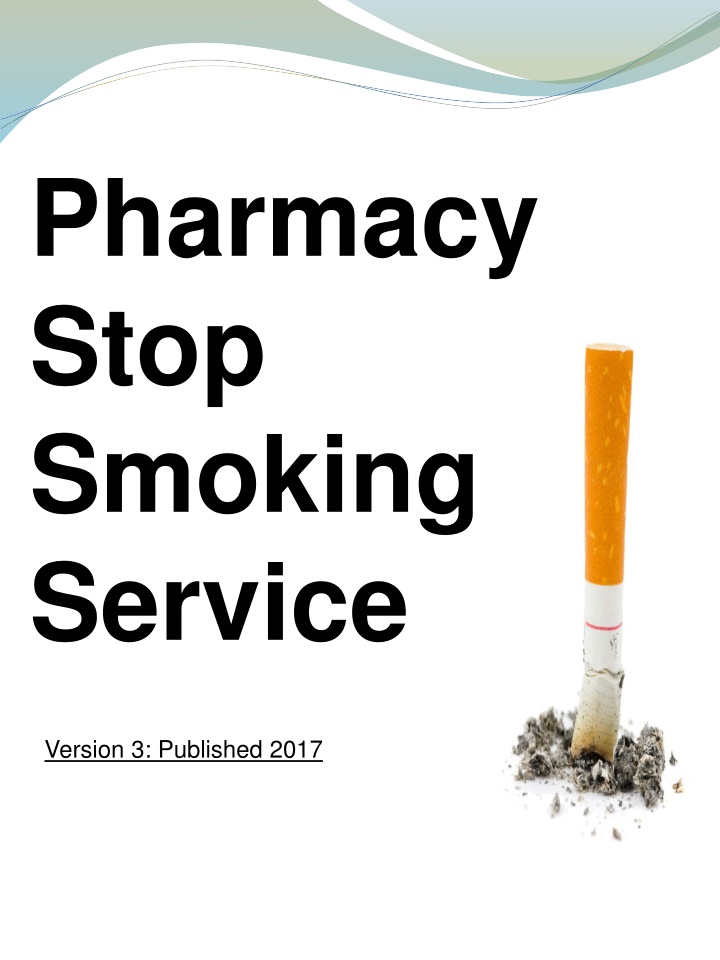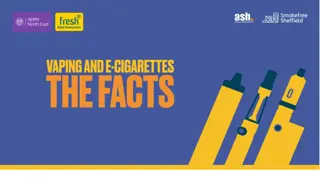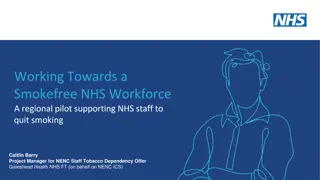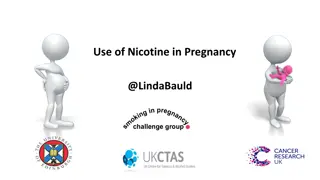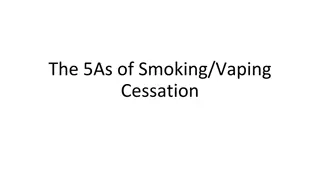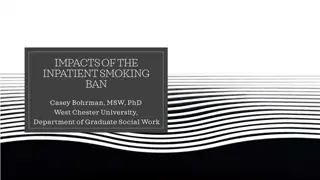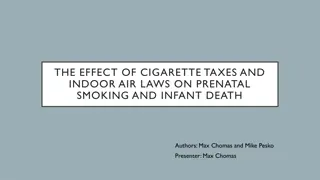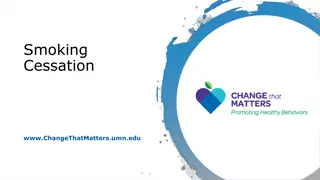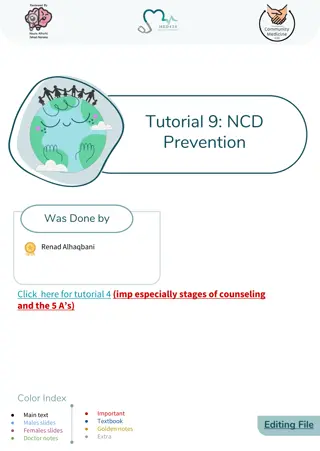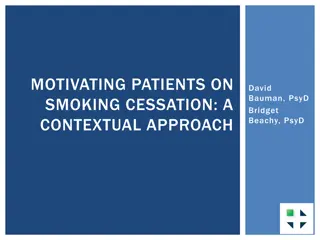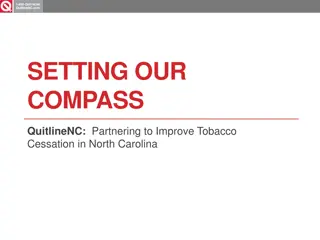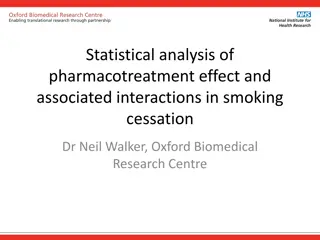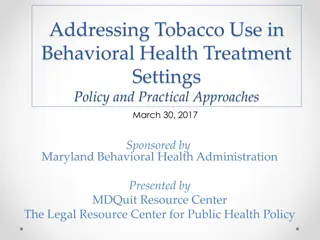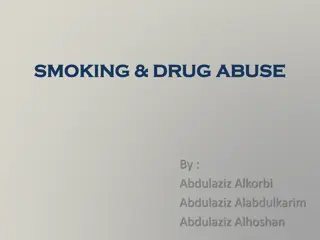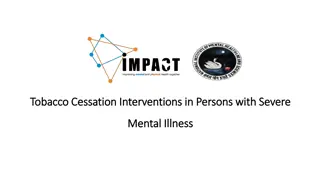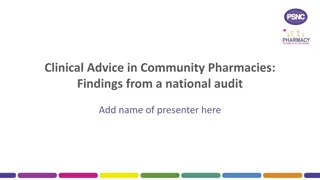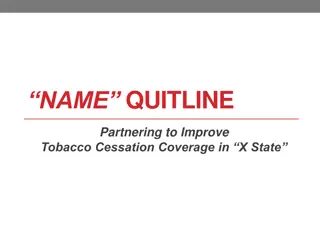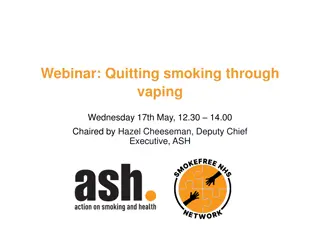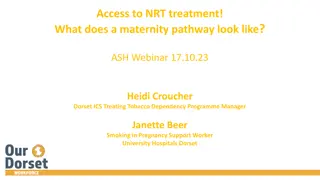Comprehensive Guide to Smoking Cessation Services in Pharmacies
Explore a detailed guide on smoking cessation services in pharmacies, including treatment flowcharts, NRT product guidelines, patch guidelines, Varenicline benefits, CO monitor information, FAQs, and more. Learn about patient assessment, treatment options, follow-up protocols, and successful outcome criteria. Utilize the provided resources to support clients in their journey to quit smoking effectively.
Download Presentation

Please find below an Image/Link to download the presentation.
The content on the website is provided AS IS for your information and personal use only. It may not be sold, licensed, or shared on other websites without obtaining consent from the author.If you encounter any issues during the download, it is possible that the publisher has removed the file from their server.
You are allowed to download the files provided on this website for personal or commercial use, subject to the condition that they are used lawfully. All files are the property of their respective owners.
The content on the website is provided AS IS for your information and personal use only. It may not be sold, licensed, or shared on other websites without obtaining consent from the author.
E N D
Presentation Transcript
Pharmacy Stop Smoking Service Version 3: Published 2017
Smoking Cessation in Pharmacy Contents 1. Smoking Cessation treatment flowchart 2-3. Nicotine Replacement Therapy (NRT) Product Guidelines 4. Nicotine Replacement Therapy (NRT) Patch Guidelines 5. 6-7. 8. Varenicline (Champix) and Stop Smoking Support I Varenicline (Champix) and Stop Smoking Support II and III Stop Smoking Support health benefits timeline 9. Tobacco equivalents for cigarettes 10-17. Smoking Cessation Pharmacy Care Record (PCR) Quick Guidelines information 18. Smoking cessation consumables order form 19. Carbon Monoxide (CO) monitor information sheet 20. Carbon Monoxide (CO) monitor maintenance flow chart 21-23. Frequently asked questions l, ll and lll 24. List of useful contacts 25. List of useful websites 26. Online training courses for all Pharmacy staff
BRIEF ENCOUNTER (Pharmacist/Support Staff) INITIAL DATA CAPTURE ON PCR GIVE LITERATURE + QUIT DATE APPOINTMENT (Pharmacist/Trained Support Staff) S Week0 M O K I N G C E S S A T I O N T R E A T M E N T F L O W C H A R T QUIT DATE: INITIAL APPOINTMENT Enter data on PCR and SUBMIT: initiates 1st Remuneration of 30 (Pharmacist/Trained Support Staff) Week 1 CLIENT ATTENDS WEEKLY Enter each contact on PCR. All sections must be completed, and at least three attempts must be made to contact patient at 4 and 12 weeks follow up by Pharmacy, even if they have not returned or are unsuccessful. SUBMIT DATA BETWEEN DAYS 28 AND 42 on PCR For all clients i.e. successful, unsuccessful and lost to follow up. Only smoke free clients can continue with the service . Week 4 Initiates 2nd Remuneration of 15 Week 10 Patient Status: Smoke Free. Assess ability to reduce and stop treatment by week 12 Option 1 Option 2 Option 3 Nearly able to cope without treatment Will cope without treatment Unable to cope. Needs support and treatment beyond 12 weeks. Reassess Patient Status Refer to Stop Smoking Service Week 12 SUBMIT DATA BETWEEN weeks 12 -14 on PCR, For all clients i.e. successful, unsuccessful and lost to follow up. Initiates 3rd Remuneration of 35 Option 1 Option 2 Option 3 Supply a further 2 weeks treatment via CPUS Successful outcome. Congratulate Smooth transfer to stop smoking service 1 Discharge from Pharmacy
Nicotine Replacement therapy (NRT) Product Guidelines l LJF approved. PATCHContinuous Release MDD One patch WHAT Nicotine Patch 16/24 hour / 3 strengths/ 12 wk step down HOW Continuous slow release of Nicotine WHO Patients with regular smoking patterns SIDE-EFFECTS Sleep disturbance (24hour patch)/ Skin irritation CAUTIONS/CI Care Eczema/Pregnancy/Breast feeding/Major health issues LOZENGE/MINI LOZENGE Slow Release MDD 15 lozenges WHAT Nicotine 2mg lozenge/ /mini 1.5mg/4mg HOW Slow Nicotine adsorption placed between gum and cheek WHO Suitable to quell craving may use in conjunction with patch SIDE-EFFECTS Upset stomach/Wind CAUTIONS/CI Peptic ulcer/Oral surgery GUM Slow Release MDD 15 pieces WHAT Nicotine Gum 2mg (light smoker) 4mg (heavy smoker) HOW Chew for few seconds, place between gum/cheek WHO Suitable to quell craving may use in conjunction with patch SIDE-EFFECTS Jaw ache/Indigestion/Nausea/Wind CAUTIONS/CI Peptic ulcer/Denture wearers MDD = Maximum Daily Dose 2
Nicotine Replacement Therapy (NRT) Product Guidelines ll LJF Not approved, but may be prescribed using professional judgement. MICROTAB Slow Release MDD 40microtabs WHAT Nicotine 2mg sublingual tablet HOW Slow Nicotine absorption under the tongue WHO Suitable to quell craving may use in conjunction with patch SIDE-EFFECTS Upset stomach/Wind CAUTIONS/CI Peptic ulcer/Oral surgery INHALATORSlow/Fast Release MDD 6 cartridges WHAT Nicotine 15mg/cartridge, resembles a cigarette HOW Inhalation of Nicotine and Menthol vapour WHO Light smoker req.hand to mouth action, may use with patch SIDE-EFFECTS Cough initially on inhalation CAUTIONS/CI Asthmatics /Allergy to Menthol ORAL SPRAY Fast Release MDD_64sprays WHAT Nicotine mouth spray 1mg/ spray HOW Prime and spray directly into mouth WHO Suitable to quell craving may use in conjunction with patch SIDE-EFFECTS Upset stomach/Hiccups CAUTIONS/CI Oral lesions or tumours NASAL SPRAY Fast Release MDD 64 sprays WHAT Nicotine nasal spray 0.5mg/metered spray HOW Spray into both nostrils for instant hit fast absorption WHO Heavy smokers for cravings, may be used with patch SIDE-EFFECTS Headache/Drowsiness/Nasal passage irritation/Sneezing CAUTIONS/CI Driving ORAL STRIP Fast Release MDD 15 STRIPS WHAT Nicotine oral film strips 2.5mg HOW Apply to roof of mouth for instant 50 second hit WHO Suitable to quell craving may use in conjunction with patch Tolerated well in pregnancy as intermittent therapy SIDE-EFFECTS Upset stomach/Hiccups CAUTIONS/CI Oral lesions 3
Nicotine Replacement Therapy (NRT) Patch Guidelines. (ref: BNF) Nicorette Invisi Patch (16 hour) LJF approved For patients smoking 10 or more cigarettes per day 25 mg 8 weeks 15mg 2 weeks 10 mg 2 weeks Nicorette Invisi Patch(16 hour) LJF approved For patients smoking less than 10 cigarettes per day 10 mg for 4 weeks 15 mg for 8 weeks NiQuitin Patch (24 Hour) LJF approved For patients smoking10 or more cigarettes per day 21 mg for 6 weeks NiQuitin patch (24 Hour) LJF approved For patients smoking less than 10 cigarettes per day. 7 mg for 2 -4weeks 14 mg for 2-4 weeks 7 mg for 4-6 weeks 14 mg for 6-8weeks Nicotinell Patch (24 Hour) For patients smoking 10 or more cigarettes per day 14 mg for 4 weeks 7 mg for 4 weeks 21 mg for 4 weeks Nicotinell Patch (24 Hour) For patients smoking less than 10 cigarettes per day 14 mg for 4-6 weeks 7mg for 4-6 weeks 4
Varenicline (Champix) and Stop Smoking Support I. The Specification, which now includes the use of Varenicline, has been made available to the Pharmacist, giving them the option to prescribe via PGD, where clinically appropriate. A patient may then be prescribed treatment with Varenicline, if they meet the criteria listed in the PGD Pro Forma and their GP is informed of treatment by letter. A Prescribing Support Pack is available. These forms can be downloaded from the website below: http://www.communitypharmacy.scot.nhs.uk/documents/nhs_boards/lothi an/PGD_259v1_Varenicline_CommunityPharmacists.pdf The Pharmacist must also, as well as completing the PGD, have satisfactorily completed the approved training by NES Pharmacy or NHS Lothian, to include appropriate training for working under PGDs for the supply and administration of medicines. Online training MCQ 2 must be completed by the Pharmacist, which can be accessed at: http://www.nes.scot.nhs.uk/education-and-training/by- discipline/pharmacy/about-nes-pharmacy/educational- resources/resources-by-topic/public-health-and-emergency- planning/public-health/smoking/smoking-cessation/smoking- cessation-training.aspx 5
Varenicline (Champix) and Stop Smoking Support II. Mode of Action This is a first-in-class Prescription Only Oral therapy for smoking cessation, which targets the alpha4beta2 receptors with a dual mode of action. It blocks nicotine absorption, releasing low levels of Dopamine, to reduce the craving and withdrawal symptoms from smoking, and also reduce the pleasurable effects. Dosing Titrating Dose: Quit Date is set in the first two weeks Day 1-3 = 500 micrograms once daily Day 4-7 = 500 micrograms twice daily Day 8-12(weeks) = 1mg twice daily Maintenance dose post titration is 1mg twice daily for 12 weeks Where a patient is struggling at week 10 to 12, to stop, we can supply beyond the 12 weeks (see Stop Smoking Flowchart); this is another option for the pharmacist to consider and discuss with the patient. You will only be remunerated for the cost of the drug. Note: A 14 day starter pack (11 x 500microgram tabs with 14 x 1mg tabs) can be supplied for the last two weeks of treatment. Ensure the patient has clear instructions to take the tablets in the starter pack in reverse order to facilitate tapered discontinuation. Patients who cannot tolerate the adverse effects of Varenicline may have the dose lowered temporarily or permanently to 500 micrograms twice daily for the 12 week duration.
Varenicline (Champix) and Stop Smoking Support III. . Carbon Monoxide (CO) MonitorTesting Patients must have their CO tested on a weekly basis to confirm they have stopped smoking. If the patient is still smoking, at week 3-4, they should be informed that treatment with Varenicline would have to be stopped if they continued to smoke. Supply 1mg Varenicline tablets if required and make arrangements to see the patient the following week (week 4). If patient is still smoking, treatment with Varenicline should be stopped. Criteria for exclusion ( Please check PGD for full list ) Patient is under 18 years. Patient is pregnant, breastfeeding or trying to conceive. Patients suffering from renal impairment or have end stage renal disease. Patient has a history of psychiatric illness. Patient suffers from epilepsy. Patient currently on another smoking cessation therapy. Patient on any other interacting medication; please check PGD for interactions. Patient is hypersensitive to Varenicline or any of its excipients. Cautions Cardiovascular Disease (CVD) Patients with stable CVD taking Varenicline should be instructed to notify their doctor of new or worsening cardiovascular symptoms, and to seek immediate medical attention if they experience signs and symptoms of myocardial infarction or stroke. Always check the PMR and be familiar with the SPC. Side-effects (not exhaustive list) Nausea Headache Sleepiness/abnormal dreams Behavioural changes/Feelings of depression and anxiety Mood swings/Suicidal ideation 7
SMOKING CESSATION HEALTH BENEFITS TIME LINE HEALTH BENEFITS 20 MINUTES BLOOD PRESSURE/PULSE RATE/CIRCULATION RETURN TO NORMAL 08 HOURS OXYGEN LEVELS NORMAL/NO NICOTINE IN BODY CRAVINGS MAY BEGIN 24 HOURS CARBON MONOXIDE LEVELS ELIMINATED LUNGS START TO CLEAR MUCUS 48 HOURS ABILITY TO TASTE AND SMELL IMPROVE CRAVINGS MAY START BREATHING EASIER AS BRONCHIAL TUBES RELAX ENERGY LEVELS INCREASE 72 HOURS 28 DAYS SKIN IMPROVES /WALKING BECOMES EASIER CIRCULATION/BLOOD FLOW IMPROVED 3/9 MONTHS LUNG FUNCTION INCREASES BY 10% COUGH/WHEEZING/BREATHING IMPROVE 01 YEAR RISK OF HEART ATTACK FALLS BY HALF THAT OF A SMOKER 10 YEARS RISK OF LUNG CANCER FALLS BY HALF THAT OF A SMOKER 15 YEARS RISK OF HEART ATTACK FALLS TO THE SAME LEVEL TO ONE WHO HAS NEVER SMOKED 8
Tobacco Equivalents for Cigarettes PIPE smokers One Bowl = 2.5 Cigarettes CIGAR smokers One Cafe Cr me Cigar = 1.5 Cigarettes One Hamlet Cigar = 2.0 Cigarettes One Havana Cigar = 4.0 Cigarettes Roll Your Own loose Tobacco 25gms(1oz)=50 Cigarettes 7days=7cigarettes/day 50gms(2oz)=100Cigarettes 7days=14cigarettes/day 75gms(3oz)=150Cigarettes 7days=21cigarettes/day 100gms(4oz)=200Cigarettes 7days=28cigarettes/day 125gms(5oz)=250Cigarettes 7days=35cigarettes/day 150gms(6oz)=300Cigarettes 7days=42cigarettes/day 9
Smoking Cessation and Pharmacy Care Record (PCR) Quick Guide lines Information. Before starting a new assessment check the following: Does the patient consent to Follow Up? If not, do not proceed, as it is no longer permitted under the new guidelines. Consent is registered by the signature on the back of the CPUS. The patient needs to be made aware of this at the time of signing. Once patient details are input into the PCR the CHI look up will ensure you have accurate details; it will check for any other quit attempts at other community pharmacies recorded in the last 12 weeks. A new quit attempt cannot be started at another pharmacy until 12 weeks have elapsed since the original quit date was set. If the patient wishes to make a further quit attempt sooner they must return to the original pharmacy where a quit date can be set within the 12 weeks. Otherwise they should be asked to use the time to prepare for the quit attempt and come back when the 12 weeks are over. Selecting the patient It may be necessary to create a record for the patient. The mandatory patient information for stop smoking patients differs from other PCR requirements and the following additional information is required: CHI number: Use the CHI look up function; this ensures that any stop smoking record made from an existing PCR at a later date will not be rejected. It is worth using this function for all PCR entries for all services. If a patient has no CHI or is not GP registered, refer to Stop Smoking Services. Address: Insert full postal address. Full Postal Code: Please ensure this is entered correctly and in full or the submission will be rejected. Home or mobile phone number or e-mail address Submission of data sets After each submission, check that the Minimum Data Set (MDS) section Status is shown as Validated and the Release Status as Submitted . Prior to releasing the 4 week and 12 week submissions, update the MDS section with product use and how many weeks of treatment given. 10
Reimbursement A CPUS form should still be completed for product reimbursement purposes. The patient s CHI number must be included. Quit attempt event MDS submission Remuneration basis At the end of each calendar month a count will be made, by Practitioner Services Division (PSD), on the central smoking cessation database of patients for MDS submissions for new quit attempts that meet the validation requirements. Submission of the MDS information with confirmed quit date (normally first return appointment) To be electronically submitted once the quit-date is confirmed with client. This will form the basis of the timelines for the 4-week and 12-week post-quit date follow-ups. 30 At the end of each calendar month a count will be made, by Practitioner Services Division (PSD), on the central smoking cessation database of patients for MDS submissions for the 4-week stage that meet the validation requirements. To be electronically submitted immediately after the 4-week post-quit date and not later than 6 weeks from the confirmed quit-date. Four week post-quit date 15 At the end of each calendar month a count will be made, by Practitioner Services Division (PSD), on the central smoking cessation database of patients for MDS submissions for the 12-week stage that meet the validation requirements. To be electronically submitted between 12 and 14 weeks from the confirmed quit-date.,(If the patients quit attempt is known to have failed during the period the PCR may be submitted between 10 and 14 weeks.) Twelve week post-quit date 35 Smoking Cessation Support Tool on PCR It has come to our attention that if the PCR Support Tool for Smoking Cessation Assessment has been marked as Complete in error, no further information can be documented on the PCR for that patient s quit attempt. If you find yourself in this situation, to continue to record the service provided to this patient you must : Create a duplicate Smoking Cessation Support Assessment entry on the Patient Care record (PCR); no further action needs to be taken by the Pharmacy, you will be subsequently contacted by the stop smoking service as to which entry you wish to submit. 11
Initial Data Capture Client must consent Select type of therapy and record number of weeks used so far This will be zero IMPORTANT NOTE: These fields must be updated before each of the subsequent submissions at weeks 4 and 12 Record the date on the referral or the date of initial patient contact and tick the box for the appropriate referral source. Where Varenicline is selected additional questions will be presented Please ensure the correct referral is identified ie Pharmacy Record date of first contact and select One to One sessions We can work in conjunction with the Stop smoking service, where they are able to give extra support to the client. 12
Start Quit Attempt and Confirm Quit Date Before recording the quit attempt information, any missing data will be highlighted. Use the Edit initial data capture or Edit patient links to update. The quit date is not editable and drives the dates for the 4 week and 12 week submissions. It is recommended that at the point of initial appointment a provisional date is discussed but only recorded at the first return appointment. You should therefore click the Cancel Button when the Confirm Quit date and record contact screen is displayed after entering the initial data. When the client returns on the agreed date (around 7 days after initial visit) use the link in the Next Action section to record the quit date and first contact. Record Quit date, this should be within the next few days Record the Contact date; this can pre- date the Quit date to allow for supply of product in preparation of quitting Where Varenicline is provided the pharmacist must be involved in follow-up consultations The data will be electronically submitted when the Confirm quit date button is clicked Please continue to follow local Formulary guidance when supplying products. Use professional judgement if prescribing outwith the LJF. **If appropriate, e.g. patient is sufficiently prepared, the quit date and contact can be recorded at the initial appointment.** 13
Recording a contact Record a contact each week as current practice. If this is not possible record the date and type under the Contact Attempt section. Please follow current Formulary guidelines and select appropriate treatment option CO monitoring should if possible be recorded weekly and especially at weeks 4 and 12 post quit If no response after two missed visits and three contact attempts, the patient is lost to follow-up, send 4 or 12 week submission at appropriate time parameters, then mark as assessment complete. Check the reports function button regularly, i.e. at least once a week to keep you updated on the status of all your patients. You can find this on the toolbar. 14
Submit 4 Week Data The link to release the data will be made available in the Next Action section between 4 and 6 weeks. (28 Days to 42 Days) It is not possible to submit the data if this submission window is missed and payment will not be made. Smoking Cessation Review Page IMPORTANT NOTE: If you miss the 6 week deadline window, it will not be possible to make a submission and payment will not be made If the patient was not successfully contacted at the 1 month follow up, or has smoked, it will not be possible to progress to the 12 week submission Before submission it is necessary to update the Pharmaceutical usage and Pharmaceutical usage weeks fields in the initial data capture. Use this link to access the fields to update 15
Submit 12 Week Data The link to release the data will be made available in the Next Action section between 10 and 14 weeks. IMPORTANT NOTE: If you miss the 14 weeks deadline it will not be possible to make a submission and payment will not be made; always check review page. It is not possible to submit the data if this submission window is missed and payment will not be made. IMPORTANT NOTE: If you miss the 14 week deadline window, it will not be possible to make a submission and payment will not be made, always check review page Before submission it is necessary to update the Pharmaceutical usage and Pharmaceutical usage weeks fields in the initial data capture Use this link to access the fields to update If the patient was not successfully contacted at the 4 week follow up, or has smoked it will not possible to complete the 12 week submission 16
Recording the Assessment Outcome Lost to follow up: If at any point the patient is no longer attending the pharmacy and is not contactable, it should be recorded in the Assessment completion section as Client lost to follow-up. Unsuccessful: If the patient is found to have smoked in the 2 weeks prior to the 4 week submission or smoked more than five cigarettes since the last submission at week 12 an Unsuccessful result should be recorded. Successful: If the patient has quit at week 12 then the assessment should be recorded as Successful. At least 3 separate attempts must be made to contact the patient at week 4 and 12 before recording that they have been lost to follow-up. If no response after two missed visits and three attempts, still submit at week 4 and 12 in given timescales. Smoking Cessation Reports Additional reports have been created to support the stop smoking service. It is recommended that you familiarise yourself with these and in particular: Expiring within next 7 days If a submission is missed it is not possible to proceed and payment will not be made No interactions in last 7 days. When viewing the reports, be aware that the Week counter is set Mon- Sun. This means that a patient could have their first contact on a Friday and show as Week 1 and then on the following Monday show as Week 2. 17
Stop Smoking Support Service Order Form Item Pack Size Quantity CO Monitor Antiseptic Wipes Alcohol Free 50 x CO monitor Disposable Mouthpieces 250 x CO Monitor D Piece Connection 12 x Motivational Money Box 1 x Poster A3/A4/A5 1 x Variety of Resource Materials for Quit Kits Tick if required Pharmacy Details: Name: Address: Email. Tel.No. To order Stop Smoking and Stay Stopped booklets and other resources. email the Health Promotion Resource Centre on: www.nhslothianhpac.scot.nhs.uk To order any of the listed items, please indicate quantity required, complete and email to: gditano@nhs.net 18
Carbon Monoxide (CO Monitor) Information Sheet. Carbon Monoxide (CO) is a poisonous gas. When a smoker inhales from a cigarette, CO is absorbed into the blood stream, through the lungs, binding to the Haemoglobin, depriving the body of vital oxygen. CObreath testing, using a monitor, shows the amount of CO in the smoker s breath (ppm), which is a measure of blood Carboxyhaemoglobin (%COHb). COmonitors record the amount of CO in the smoker s breath, which indicates the level of some 4000 toxic substances, 60 of which are known carcinogens, in cigarette smoke. CO readings should show the level of a non-smoker after 24 hours. CO testing should be conducted a minimum of 10 minutes after a cigarette. CO testing is best done later in the day to give an accurate reading. CO monitors are a powerful supportive tool when helping patients to stop smoking, by showing them the benefits of having low CO readings, within 24 hours of stopping smoking. It may also be used where you suspect a patient is smoking. All Lothian Community Pharmacies have received new, self-calibrating monitors and consumables; please ensure they are stored safely as they are costly. If you require more consumables, or if a problem arises with your monitor, please contact me, on gditano@nhs.net It is good practice to test your patients at every visit. If possible you must at least check at Week 1, Week 4 and Week 12. To Download a CO Readings Wall Chart, CO Patient Record Card, or if you require a consumables order form, visit 19
Flow Chart Protocol for the maintenance of your CO Meter After each patient use Change the disposable mouth piece (straw) Each day / before use Cleanse CO Meter and D Piece using either Non Alcoholic Instrument Cleansing Wipes Or a damp tissue NB: The sensor must not be wiped with any Alcoholic Solutions or be allowed to get wet. Every month Replace plastic D-piece with a new one if used regularly If minimal use (e.g. 4 times a month) replace D-piece every 3 months. Patient use If the patient has been drinking alcohol or smoking E cigarettes, do not use monitor, as this may damage the CO monitor NB. To re-order any CO Monitor Sundries or any problems with Monitor, contact Giovanna at gditano@nhs.net CO Wall Chart, Record Cards, sundries order form may be downloaded from: 20
Frequently Asked Questions I How many patients should we be seeing? There is no defined minimum or maximum number of patients that each pharmacy should deliver, but we do all need to be offering the service. Experience would suggest that there should be a reasonable through put for your staffing levels. Your contribution is needed in order for NHS Lothian Community Pharmacies to meet their proportion of the HEAT Target. Can patients use the service to cut down? No, evidence for success is really poor though, and it is a condition of the pharmacy service that the patient is motivated to stop completely. If patients are looking to cut down before stopping they can always purchase their own NRT and once they are ready to commit to a quit attempt, then they can be prescribed a product. Can we re-start a patient who has recently had a failed attempt? Yes, although guidelines normally recommend waiting six months, this is not a part of our service specification. It would be up to the Pharmacist prescribing, if they assessed the patient as being ready for another quit attempt. Therefore, if in your professional opinion the patient is ready for another quit attempt, a shorter interval could be justified. Can we prescribe more than one form of NRT? Yes; Combination Therapy is now good practice and is recommended. We do however need to ensure that our prescribing is of good quality and represents value for money. Do I need to have a consulting room? No, this is not a requirement. As long as you can provide a reasonable level of privacy with which the patient is satisfied, the service may be offered. 21
Frequently Asked Questions ll Can we prescribe in pregnancy/breast feeding? Yes, intermittent therapy is usually preferred to continuous therapy in these patients; ideally the patient should initially try quitting without NRT, (see LJF). However, specialist advice is available, if necessary, from the Stop Smoking Service : All Areas. Can we prescribe where there are complex health issues? e.g. Unstable CardiovascularDisease, Kidney Failure Yes, intermittent therapy is usually preferred to continuous therapy in these patients; ideally the patient should initially try quitting without NRT, (see LJF). However, specialist advice is available, if necessary, by calling Stop Smoking Service Hospital Advisor: Tel.no. 01506 523 871 (All Areas). Can we prescribe where there are Mental Health Issues? Yes, care however must be taken if a patient is taking certain drugs, such as Clozapine. These patients should have their blood levels closely monitored, and their GP should be informed. Cigarette smoke causes the body to break down Clozapine more quickly. This means that if you smoke you probably need a higher dose to get the same benefit as a non-smoker. You would be best to liaise with their mental health professional looking after them, so that they can check what changes need to be made. If the patient stops smoking without planning, they may start to experience adverse effects of Clozapine after 1-2 weeks. It is the cigarette smoke which causes this effect and not nicotine, therefore using nicotine replacement (NRT) will not prevent it. However specialist advice is available, if necessary by calling Stop Smoking Service Mental Health Co coordinator: Tel.no. 0131 537 6525. 22
Frequently Asked Questions lll Can we prescribe where there are Issues of Cannabis Use? Yes, you would treat these patients as any other patient; you would firstly clarify if they are willing to stop using cannabis. It is recommended they stop their cannabis use before stopping smoking tobacco. However, specialist help and advice, if necessary, is available by calling Specialist Cannabis Worker: Tel.no. 01506 430 225. Can we prescribe NRT for Young People? Yes, you can prescribe over the age of 12 years, as you would for an adult, but you firstly must have informed consent and take a CO reading to help assess nicotine dependency. Always check product guidelines before prescribing, (see LJF). However, specialist help and advice, if necessary, is available by calling Stop Smoking Young Persons coordinator: Tel.no. 07969 530 266. Can we prescribe where patients are on certain drugs that may interact or have an effect with NRT? Yes, care however must be taken if the patient is taking certain drugs, such as Warfarin or Aminophylline. These patients should have their blood levels closely monitored, and their GP should be informed. However we can refer to specialist help if necessary, Stop Smoking Service Specialists: Tel.no. 01506 523 871 (All Areas). Can we prescribe where patients have certain disease states that may be affected by NRT? Yes, care however must be taken if patient has diabetes. These patients should monitor their blood glucose levels more closely, and they should seek help and advice from whoever normally monitors their condition. However, we can refer to specialist help if necessary, Stop Smoking Service Specialists: Tel.no. 01506 523 871 (All Areas). There is a Smoking Cessation Clinic nearby; can I still offer the service? Yes, we need to widen access to smoking cessation services and the pharmacy service is ideal for those who may need greater convenience and flexibility than clinics can offer or who simply prefer to come to their pharmacy. 23
List of useful contacts. Primary Care Stop Smoking services West Lothian; 0150 665 1829 Midlothian ; 0131 537 9914 East Lothian; 0131 537 9914 North Edinburgh ; 0131 537 4352 South Edinburgh; 0131 537 7154 Young People; 07969 530266 Cannabis Worker; 0150 643 0225 Mental Health; 0131 537 6525 Smoke line; 0800 84 84 84 24
Useful Websites Smoking Cessation Information NHS Lothian Community Pharmacy Local Website Information pack/ Downloads /Letters/Initial Data Capture and Tracker Sheet/Certificates http://www.nhslothian.scot.nhs.uk/Services/Pharmacies/CommunityPharmacy/Pages/StopSmoking.aspx Smoking Cessation Service Revised Specification (PHS) http://www.sehd.scot.nhs.uk/pca/PCA2014%28P%2912.pdf Patient Group Direction (PGD) Varenicline for NHS Lothian http://www.communitypharmacy.scot.nhs.uk/documents/nhs_boards/lothian/PGD_259v1_Varenicline_ CommunityPharmacist.pdf Information on Smoking Cessation Specification Community Pharmacy Scotland http://www.communitypharmacyscotland.org.uk/nhs-care-services/services/public-health- service/phs-smoking-cessation-service/ Flow Chart and Formulary specification Lothian Joint Formulary (LJF) http://www.ljf.scot.nhs.uk/LothianJointFormularies/Adult/4.0/4.10/%28j%29/Pages/default. aspx Equality and Diversity/Translation, Interpretation and Communication Support http://www.nhslothian.scot.nhs.uk/YourRights/ Health Promotion Resource Centre www.nhslothianhpac.scot.nhs.uk www.canstopsmoking.com www.nhslothian.scot.nhs.uk www.ashscotland.org.uk NHS Lothian Community Pharmacy Smoking Cessation Service, Lead Pharmacist ; Giovanna Di Tano Pharmacy office: 01315376625 Email address: gditano@nhs.net 25
Online training courses for all Pharmacy staff Online training courses for all Pharmacy staff (NES) www.portal.scot.nhs.uk Raising the Issue www.smoking1.nes.scot.nhs.uk The Pharmacy Model www.smoking2.nes.scot.nhs.uk MCQ1 and MCQ2 /Varenicline and PGD Training (NES) http://www.nes.scot.nhs.uk/education-and- training/by-discipline/pharmacy/about-nes- pharmacy/educational-resources/resources-by- topic/public-health-and-emergency-planning/public- health/smoking/smoking-cessation/smoking- cessation-training.aspx 26
